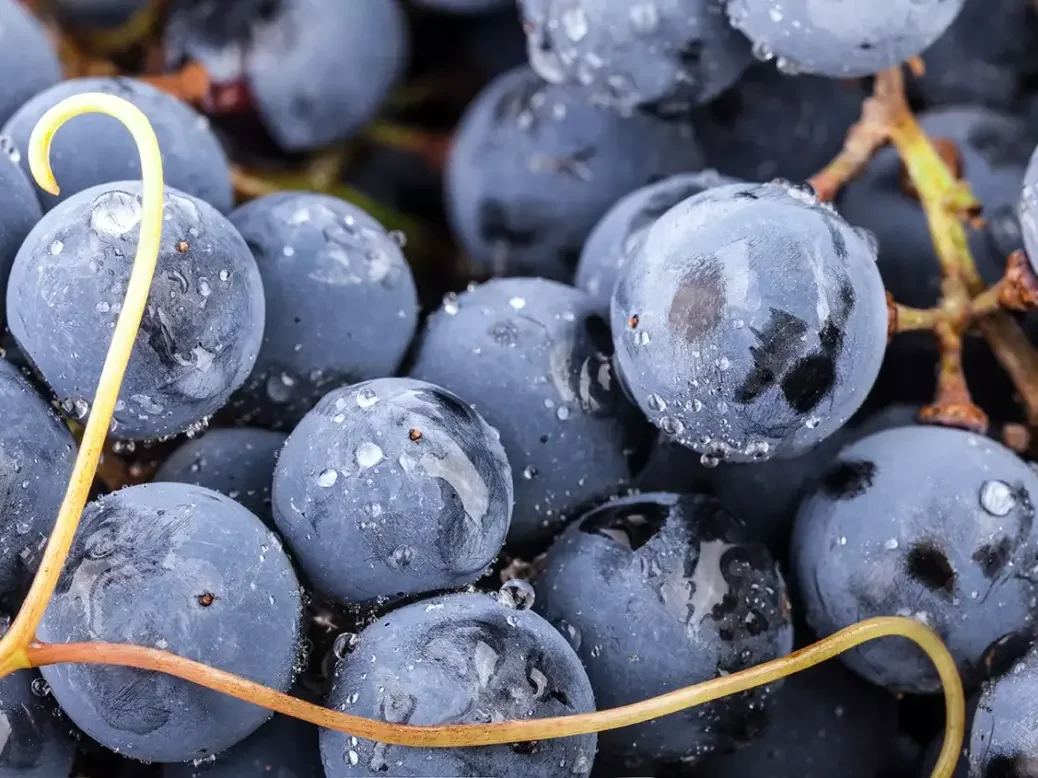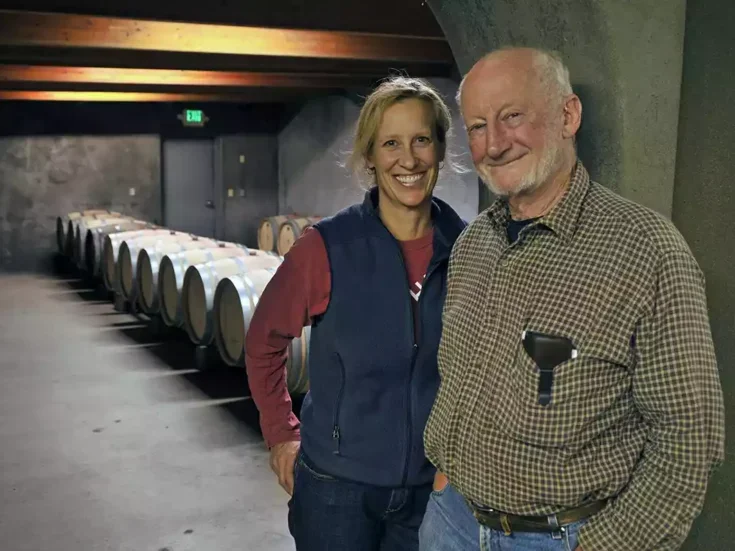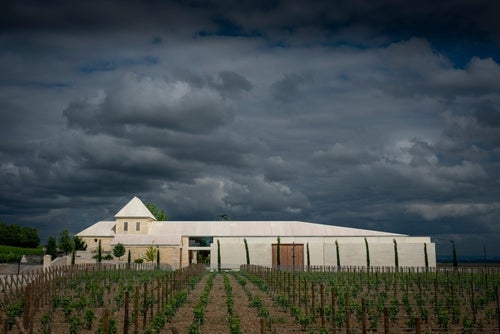
Australian producers led a field that included some of the biggest names in Argentina, Chile, New Zealand, and South Africa at a tasting of consistent quality that showed why Cabernet Sauvignon is so enduringly popular, says David Williams, who was joined by Simon Field MW and Anthony Rose.
For scores and detailed notes on all 32 wines included in the tasting, subscribe to The World of Fine Wine.
There is no more widely planted wine grape variety in the world than Cabernet Sauvignon. Indeed, according to the OIV, there is only one grape variety of any kind that trumps its vast acreage: The juicy, distinctively “foxy”-flavored table grape variety Kyoho, widely planted in East Asia, and particularly China, tops the list with 365,000ha (902,000 acres), just about putting it ahead of Cabernet Sauvignon’s 341,000ha (843,000 acres).
No less impressively, according to the latest (2020) edition of the world’s most comprehensive compendium of grapevine stats, Which Winegrape Varieties Are Grown Where? by Professor Kym Anderson and Dr Signe Nelgren of Adelaide University, Cabernet’s ascent has not yet reached its peak: Cabernet’s surface area grew by almost 90,000ha (222,000 acres) between 2000 and 2016, its expansion second in that time only to Tempranillo, the telling difference being that almost all of Tempranillo’s growth was in Spain, whereas Cabernet’s was distributed across most of the wine-growing world. If you set the starting line back a decade earlier, you find the Cabernet vineyard has tripled since 1990, when it was the seventh-most planted variety in the world. In total, it occupies more than 4 percent of the world’s total vineyard (including table grapes), according to the OIV data. Or to use the British media’s standard unit of comparative measurement, it is now equal to just shy of one fifth of the landmass of Wales.
Its near ubiquity stems from its quite remarkable adaptability. It’s not true to say that Cabernet can grow anywhere—late-ripening, thick-skinned, and small-berried with a high pip-to-juice ratio, it works best and most consistently in a wide but still circumscribed climatic band that runs roughly from the upper end of temperate (a growing-season average of 61.7°F [16.5°C]), to the lower end of hot (a growing-season average of 67.1°F [19.5°C]). Within those parameters, however, it can thrive in a broad range of soils (as became apparent in this tasting), and it seems capable of expressing an essential Cabernet-ness no matter the quality level, winemaking technique, origin, or stylistic ambition (a characteristic that makes it very different from its white equivalent, Chardonnay).
For producers, the sheer popularity of Cabernet is of course a significant part of its appeal, since it offers a ready-made audience who know, or think they know, what they’re getting; it has, as they say, strong brand recognition. The other side of the story is that by choosing to make a Cabernet, you are entering the wine world’s most competitive field, alongside some of its most famous and most highly remunerated performers. That presents the ambitious producer with the daunting, exhausting task of persuading wine drinkers that theirs is a wine that can compete with the established thoroughbreds in Bordeaux, Bolgheri, and Napa, which between them make most of the top-end-Cabernet running and (according to Liv-ex) dominate the secondary market for wines made from the variety.
Cabernet Sauvignon below the equator
How are the subjects of this tasting, the producers of the five major southern-hemisphere wine countries, shaping up in the great global Cabernet race? In terms of plantings, Chile—where Cabernet is by far the most widely planted variety, occupying more than 20 percent of the total vineyard—leads the way according to the country’s most recent statistics (2021), with 37,500ha (92,700 acres), a number that puts it fourth in the world overall after China, France, and the United States. Next comes Australia, where Cabernet, with 25,000ha (62,000 acres), or 18 percent of the total, is the second-most planted variety, albeit some distance behind Shiraz/Syrah. Argentina takes third place, with 14,000ha (35,000 acres) of Cabernet, around 7 percent of the country’s total vineyard (Malbec, for comparison, has 46,000ha [113,000 acres]), while South Africa has 9,500ha (23,000 acres), making Cabernet the fourth-most planted variety and the most planted red. Finally, New Zealand brings up the rear, with just 207ha (512 acres), almost of all of which (183ha [452 acres]) is planted in Hawke’s Bay.
So much for scale; what about quality? Here, at least as far as this tasting went, there is a clear leader; indeed, I can’t remember any comparable, comparative WFW tasting offering a more convincing conclusion. Australia simply romped home, occupying each of the top seven places, and eight of the top ten. Even its lowest-positioned wine (the 2018 Cyril Henschke) managed a respectable 16th place.
The result is all the more striking for being at least a little unexpected. Given the opportunity to predict our scores, based on previous experience not only of the general level of Cabernet in each country but of previous vintages of these very wines, Australia would certainly have done well. But none of us would have come up with such a one-sided result. Similarly, I don’t think the Australian dominance on this occasion is indicative of any preference among the group for Australian wine per se or for a single Australian style or approach to Cabernet. Anthony Rose points out that “Australia’s ten wines showed not only high quality but also regional diversity and stylistic difference. The relative elegance and freshness of Yarra Valley and Margaret River, the richness and body of Coonawarra, and the complexity of the cross-regional blend all came across.”
What impressed me most about the Australian wines was their individuated personalities, which, while certainly a corollary of their diversity of origin (a diversity that was not on offer from any of the other countries featured here), is not just about that. The best of the Australians had the spark of specificity that marks out all the finest wines; while all recognizably Cabernet Sauvignon, they had—to borrow an apt and evocative phrase used by Francis Percival during the WFW skin-contact white tasting that took place the previous day—“escaped their varietal prison,” offering in their various ways so much in the way of expressive and multilayered detail.
As sports pundits like to say, sometimes the quality of the winning performer can make defeated rivals look much worse than they really are. And while, as Anthony says, the South African entries “didn’t distinguish themselves,” in context (with the notable exception of the cool-climate high-altitude Cederberg), and while as a group New Zealand failed to excite, the base level of quality among the entrants was very high, with each of us finding wines to please from each of the countries. No wine averaged fewer than 87.3 points (“a good wine with no outstanding features,” according to the WFW scoring system), while the rest were fairly evenly divided between “very good” and “outstanding.”
Australia’s dominance aside, the most notable finding to emerge from this tasting is just how much more balanced this group of wines is now than it would have been a decade or even five years ago. As Simon Field MW noted, this is most evident in the alcohol levels. After years of sometimes-overbearing potency and a short spell of over-compensatory, early-picked stridency, the wines seem, on this evidence, to have settled somewhere “elegant and composed.” Oak use, too, is much more sensitive, with, as Anthony says, “Just about all the producers here show[ing] their expertise in the vineyard and the cellar.”
“All good, all in all,” as Simon put it: This was a tasting that reminded us why Cabernet still rules so much of the world.
The Top 5: The best southern hemisphere Cabernet Sauvignon
Yarra Yering Carrodus Cabernet Sauvignon Yarra Valley Victoria Australia 2018 (13% ABV) |95
Simon Field MW | Pure and bright, crimson tints evidenced, and a delicious nose of inverted classicism and subtle plush; red fruit descants, finely interwoven with darker, spicier fruit; chalk, plum, and gravel too. This has an Old World aroma, if that’s not too demeaning a thing to say. The chalky tannins are very fine, the fruit gentle and softly layered: a bucolic watercolor in a gallery dripping with heavy oil. Just the slightest hint of sapidity, elegantly rejoined and underwriting intent, with which one is more than happy to concur. | 96
Anthony Rose | Still relatively vivid in color but starting to evolve nicely. The aromas are still in their infancy, slightly shy and brooding, but promisingly fresh, with a hint of chocolaty oak and spice; the elegantly medium-bodied blackcurrant fruit is evolving to the point where fresh, almost crisp, cool-climate acidity and softening tannins are starting to integrate beautifully with a savory quality and spicy oak into an elegant style of wine, making it approachable now and likely to continue on an upward trajectory for 10 years plus. | 94
David Williams | Margaux on the Yarra, with a perfumed lilt to the nose. There is lovely fruit detail here in a red-fruit zone, and gorgeous succulence, lightly worn, very fine tannins, brightness, and harmony and a seamless feel; a long, tapering finish full of energy and life. Perfectly poised. Just lovely. | 95
Penfolds Bin 707 Cabernet Sauvignon South Australia Australia 2010 (14.5% ABV) |94
SF | Dense, near opaque, its age hard to discern. There is a little volatility here; an old library that has kept the curtains down; not musty, just evolved, maturing at a regal pace. The VA piques the palate, too, adding a poetic lift, but also, maybe, compromising the structure, which seems to have been built to last. Dark chocolate, hints of tapenade, seaweed, even; a garnished finish, reassuringly poised, enfin. | 92
AR | This is showing huge depth of color, despite its relative maturity; and it’s still remarkably fresh and young when you take that first sniff, with a bouquet of brooding oak spice and dark fruit; and when you taste, there’s a richness and depth of flavor indicating that it’s needed this length of time in bottle even to get to first base, a hint of charry oak incorporating mouthwatering cassis fruit and spices in an immense mouthful of fruit—so much so, that while you wouldn’t exactly call this wine elegant. You have to say that it more than compensates by way of a hugely satisfying mouthful of seductive fruit, and given its relative youthfulness now, it surely has at least another couple of decades of life ahead of it—probably more. | 95
DW | Super-rich, dense, powerful, baking-spice and dried-fruit notes emerging alongside cigar box, fig, and a touch of soy. Age has in this instance brought complexity and savory interest; the palate is full of contrast, with appetizingly textured tannins and a sweetly stylish finish. Still young, with so much tannin and substance, and lots of evolution still to come. | 95
Wynns Coonawarra Estate John Riddoch Cabernet Sauvignon Coonawarra Australia 2020 (13.5% ABV) |93.7
SF | A dense stain of color, then a nose of woodsmoke and soot; one has to swirl with vigor to release the fruit quota, made up, surprisingly, by red apples, blackberry, and fruits of the forest. There’s also a hint of coulis behind the tar, gravel, and roses. Stentorian but grown-up tannins, grippy, for sure, but only as a gift from ripe fruit and expensive wood. Behind the reserve, there is charm—and behind the charm, a genuine seriousness that stretches the entire length of the palate. Precocious, but also brimming with vitality and potential. | 93
AR | This is so youthful and primary that the colors practically stain the side of the glass when you swirl it. There’s a brooding depth to the aromas, which are still a little on the shy side but gradually reveal themselves as sweet, spicy, and cassis-like, with an underlay of stylish oak. The fruit has excellent purity and concentrated ripeness encased in a framework of well-balanced fresh acidity and firmish, but not too firm, tannins. Still young and primary, it’s on the cusp of developing further complexity as it spends time in bottle, which it’s going to need for its superior virtues to shine. | 95
DW | Vivid, dark, inky color, and wonderfully pure and vivid fresh blackcurrant compote on the nose; a touch of black cherry, too, in both flavor and a glossy-cherry-skin feel on the palate, which has wonderfully fine, polished tannins. Juicy, succulent, long, fruit-filled finish. A joyful expression of Cabernet fruit that is immediately attractive but has the guts to age for many years. | 93
Robert Oatley The Pennant Frankland River Cabernet Sauvignon Australia 2018 (14.5% ABV) |93.3
SF | Of a dark tenebristic hue; uncompromising. The nose is more forthcoming, with blue fruit and spice, loganberry, crushed plum, and hints of bitter chocolate, mocha, and eucalypt—all in all, very attractive. The palate is equally generously disposed, the purity of fruit bedecked in balanced acidity and with a full supporting cast of ripe fruit tannins. Vertical and poised—an attractive and rewarding example. Challenging, but we all like a nice challenge, do we not? | 94
AR | Surprisingly youthful in color, this wine comes with a powerfully aromatic whack of sweet new oak and ripe blackberry, offset by the fresh minty notes of typical cool-climate Cabernet. The fruit is nicely ripe and pure, with a minty freshness that underpins the concentrated cassis-like fruit in a substantial structure whose firm spine of acidity and mouth-coating tannins suggest that this wine is only just out of short pants and turning into adolescent youth. Drink now if you must, but it will almost certainly benefit from five years plus in bottle. | 93
DW | Rich, luxurious, settled, and succulent ripe summer-fruit compote, a swoop of blackberry and blueberry and suave, finely stitched tannins, but with a breath of maritime freshness. Very pleasurable and immediate; an accessible, fruit-filled, resonant finish. | 93
Penfolds Bin 169 Cabernet Sauvignon Coonawarra Australia 2010 (14.5% ABV) |93.3
SF | Burned heath, loamy, soft char, with briary, blackberry and plum duff; one decade down—the first of many. A rich, velvety texture, old-vine harmony lending sweetness at the end of the palate, tannins ablating time’s arrow. There is still power here, still sinewy raw potential, firmly rendered, tightly wound. This has more to give—quite a lot more. | 92
AR | This is surprisingly youthful in color, just showing a hint of garnet at the rim of the glass, for its age. The sweet, fulfilling aromas—of mint, chocolate, and cassis—have evolved well, remaining fresh and balanced. On tasting, this full-bodied red is now nicely evolved, its vanilla and chocolate oak perfectly integrated into a wine whose youthful vigor is only now just easing into a mature, grown-up phase of development, but there’s plenty of enjoyment to come over the next ten years, if you can keep it cooped up for that long. | 94
DW | Deeply inviting, mature nose. This is saturated, inky still, and has waves of fruit, but with soft tobacco and cooked fruit amid the fresher red- and blackcurrants and berries. A really lush feel, with refined tannins and just the beginnings of a wispy smokiness coming through on the complex finish. This is an extremely satisfying, rich, classically Australian Cabernet. | 94






